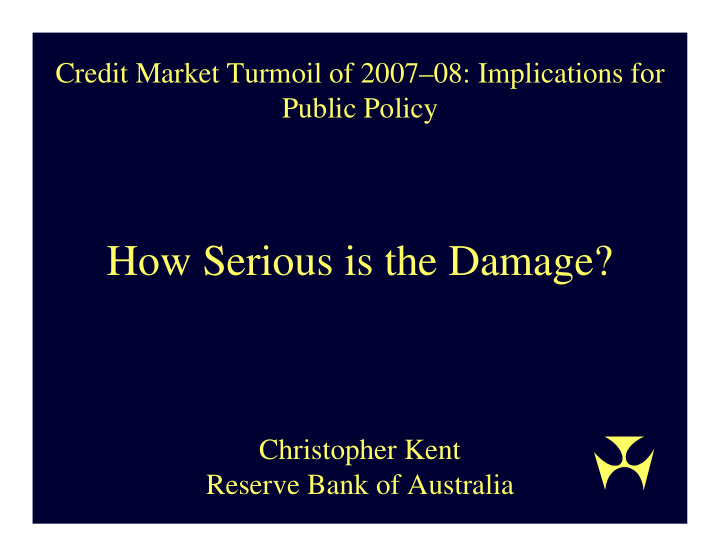



Credit Market Turmoil of 2007–08: Implications for Public Policy How Serious is the Damage? Christopher Kent Reserve Bank of Australia
Preview • Not all bubbles are created equal • Factors underpinning bubble and its resolution influence extent of – financial crisis – amplification of business cycle
Australian Experience Four episodes – cycles in credit/property 1890s 1930s 1970s 1990s D’Arcy and Kent (2000), ‘Cyclical Prudence – Credit Cycles in Australia’ Fisher and Kent (2000), ‘Two Depressions, One Banking Collapse’ Kent and Lowe (1998), ‘Property-Price Cycles and Monetary Policy’
Cycles in Australian Output, Construction, Property Prices and Credit Index Index Real GDP 120 120 100 100 80 80 60 60 % % Construction to GDP 15 15 10 10 5 5 Index Index Property Prices 120 120 80 80 40 40 % % Credit to GDP 80 80 60 60 40 40 20 20 1880 1932 1938 1960 1966 1972 1980 1886 1892 1898 1920 1926 1978 1986 1992 1998
Cycles in Australian Output, Construction, Property Prices and Credit Index Index Real GDP 120 120 100 100 80 80 60 60 % % Construction to GDP 15 15 10 10 5 5 Index Index Property Prices 120 120 80 80 40 40 % % Credit to GDP 80 80 60 60 40 40 20 20 1880 1932 1938 1960 1966 1972 1980 1886 1892 1898 1920 1926 1978 1986 1992 1998
Capital Ratios % % Capital to loans and advances 25 25 Capital to loans and advances 20 20 15 15 Capital to total assets Capital to total assets 1880 1886 1931 1892 1898 1919 1925 1937 % % 12 12 Risk-weighted capital ratio 9 9 6 6 Capital to Capital to total assets 3 3 total assets 0 0 1960 1966 1972 1978 1980 1986 1992 1998 Note: Shading indicates peaks in real GDP.
Factors underpinning costly Australian crises i. credit growth above trend PLUS ii. rapid inflation collateral prices iii. excessive concentration of investment/lending iv. lack of capital accumulation v. competitive pressures – liberalisation/innovation • i. and ii. – Borio and Lowe (2002) – speed kills • during contractions – policy matters
Patrick Honohan – Bank Failures What he says… • Overconfidence in risk management models • Detailed account of a number of ‘failing’ financial institutions • Estimates direct costs of write-downs and fiscal support • Policy? – Short-term response to failing institutions – slow, equity losers, managers? – Long-term – need less rules based, more discretionary approaches to risk management
Patrick Honohan – Bank Failures What I thought… • The problem with models – ‘Normal’ times vs tail events? – Perceived risk – recent realisations – difference from actual risk? – Perceptions better than actual in upturns, worse in downturns – Models too similar? One-sided markets • Case studies, common theme? – Rapid growth, capacity to manage/control? Driven by concerns re revenues & market-shares – e.g. UBS • ‘Successful’ institutions’ strategies? – Senior Supervisors Group (2008) • Why is capital so expensive? – Overoptimism of creditors – exit, rescue, perceived risks
David Greenlaw – Real Economy Costs What he does… • Estimates of losses by leveraged financial institutions • Assesses implications for domestic lending – balance between capital losses and asset reduction • Examines effect on economic activity – single equation estimate GDP growth link to DNFD – loan officer survey and TED spreads – used as instruments to identify true supply-side effect
David Greenlaw – Real Economy Costs What I thought… • Simplicity of approach is valuable • But, single equation as it is may miss some important effects • Financial accelerator – may make things worse – recursive feedback from real activity to financial sector: role for collateral prices, longer horizons, asymmetric effects? • Strong policy response – may make things better • Need a system of equations
S “Vish” Viswanathan –Financial Market Damage What he says… • Review of network market inefficiencies • Contrast with ‘consolidated’ markets which have: – liquidity under stress, timely & ‘accurate’ price discovery, standardised products, central clearing house, disclosure rules, resolution of defaults • Provides description of network market failures – amplification of shocks – role of collateral, margins, mark-to- market accounting • Policy? Regulatory changes needed for – More: standardisation, market makers, transparency, role for clearing houses, among other things…
S “Vish” Viswanathan –Financial Market Damage What I thought… • Discussion for existence and benefits of network markets – why don’t they move to consolidated markets? – tailored products likely to remain? But which? • How to encourage transformation? – need to focus on removing impediments to standardisation/simplification, use of clearing houses • Scope for markets to do much on their own?
Conclusion
Recommend
More recommend